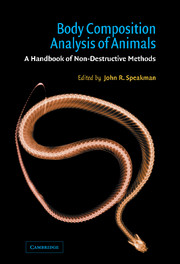Book contents
- Frontmatter
- Contents
- List of contributors
- Preface
- Acknowledgements
- Introduction
- 1 Morphological indicators of body condition: useful or wishful thinking?
- 2 Standard methods for destructive body composition analysis
- 3 The isotope dilution method for the evaluation of body composition
- 4 Gas dilution methods: elimination and absorption of lipid-soluble gases
- 5 The use of total body electrical conductivity (TOBEC) to determine body composition in vertebrates
- 6 The use of bioelectrical impedance analysis (BIA) for estimation of body composition
- 7 The assessment of body composition and other parameters by ultrasound scanning
- 8 The use of dual-energy X-ray absorptiometry for the measurement of body composition
- Index
1 - Morphological indicators of body condition: useful or wishful thinking?
Published online by Cambridge University Press: 19 January 2010
- Frontmatter
- Contents
- List of contributors
- Preface
- Acknowledgements
- Introduction
- 1 Morphological indicators of body condition: useful or wishful thinking?
- 2 Standard methods for destructive body composition analysis
- 3 The isotope dilution method for the evaluation of body composition
- 4 Gas dilution methods: elimination and absorption of lipid-soluble gases
- 5 The use of total body electrical conductivity (TOBEC) to determine body composition in vertebrates
- 6 The use of bioelectrical impedance analysis (BIA) for estimation of body composition
- 7 The assessment of body composition and other parameters by ultrasound scanning
- 8 The use of dual-energy X-ray absorptiometry for the measurement of body composition
- Index
Summary
Introduction
External measures of animal size, e.g. body mass, wing chord, foot length, and so on are often used by ecologists to develop body condition indices, e.g. body mass/length. Body condition indices are thought to reflect variation in diverse aspects of organismal quality, e.g. health, nutritional status, fat content and even Darwinian fitness (Krebs & Singleton, 1993; Brown, 1996; Viggers et al., 1998). Body condition indices are generally easy to compute, so if they are highly correlated with variables, such as fatness or health, that are difficult to measure, they may be useful to ecologists for at least two reasons. First, they may be indicators of variables, e.g. fat content, that are difficult to measure accurately without harming an animal. Secondly, they may be more efficient or experimentally simpler to measure than variables that are hard to quantify, such as health or Darwinian fitness.
Ecologists seeking rapid non-destructive methods for estimating body condition have used two basic approaches for estimating body condition from external morphology. These two approaches are based on the construction of ratio variables, e.g. body mass divided by length, and the generation of residual variables, e.g. residuals from the regression of mass on length. Use of both kinds of condition indices requires considerable care to prevent errors in inferring the biology of interest, i.e. to prevent drawing erroneous conclusions about the biology being studied. One serious problem with the use of condition indices is that apparently subtle differences in the method used to compute the condition index may lead to vastly different conclusions about an animal's condition.
- Type
- Chapter
- Information
- Body Composition Analysis of AnimalsA Handbook of Non-Destructive Methods, pp. 8 - 38Publisher: Cambridge University PressPrint publication year: 2001
- 71
- Cited by

